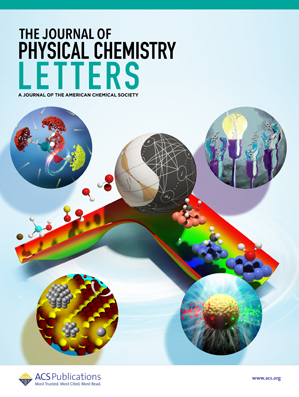Electrochemical Doping of Halide Perovskites with Silver Interstitial Ions: Mechanistic Insights and Enhanced Performance in Memristor Applications
IF 4.8
2区 化学
Q2 CHEMISTRY, PHYSICAL
引用次数: 0
Abstract
Halide perovskites have garnered significant attention for their exceptional carrier mobility, balanced bipolar transport properties, and ion-electron mixing conductivity, making them highly promising for applications, such as solar cells, photodetectors, and memristors. Despite their potential, intrinsic ions and defects within these materials complicate effective doping, and interactions between metal electrodes and perovskite materials can trigger interfacial chemical reactions that compromise device stability and performance. This study examines the influence of Ag electrodes on perovskite devices, specifically investigating the n-doping effects of Agi+ interstitial ions in MAPbI3 perovskites through an integrated approach combining first-principles density functional theory (DFT) calculations and experimental analysis. Findings reveal that Agi+ interstitial ions, generated electrochemically at Ag electrodes, penetrate the MAPbI3 structure and migrate under an applied electric field, achieving stable n-doping under controlled bias conditions. Detailed characterization of the doping process was conducted using current density–time (J–t) measurements, electrochemical AC impedance (EIS), TOF-SIMS/XPS depth profiling, and temperature/illumination-dependent studies. Additionally, the memristive behavior of the device, including doping mechanisms and the formation of metallic conductive filaments, was demonstrated, offering insights into its potential applications in advanced electronics. These findings elucidate the physicochemical interactions at metal–perovskite interfaces under bias in diode devices.

卤化物钙钛矿与银间隙离子的电化学掺杂:机理洞察和忆阻器应用性能的增强
卤化物钙钛矿因其卓越的载流子迁移率、平衡的双极输运特性和离子-电子混合电导率而受到广泛关注,这使得它们在太阳能电池、光电探测器和忆阻器等应用中具有很高的前景。尽管具有潜力,但这些材料中的固有离子和缺陷使有效掺杂复杂化,金属电极和钙钛矿材料之间的相互作用可能引发界面化学反应,从而损害器件的稳定性和性能。本研究通过结合第一性原理密度泛函理论(DFT)计算和实验分析的综合方法,研究了Ag电极对钙钛矿器件的影响,特别是研究了Agi+间隙离子在MAPbI3钙钛矿中的n掺杂效应。结果表明,在Ag电极上电化学生成的Agi+间隙离子在外加电场作用下穿透MAPbI3结构并迁移,在可控偏置条件下实现了稳定的n掺杂。通过电流密度-时间(J-t)测量、电化学交流阻抗(EIS)、TOF-SIMS/XPS深度谱以及温度/光照依赖性研究,对掺杂过程进行了详细表征。此外,还展示了该器件的忆阻行为,包括掺杂机制和金属导电丝的形成,为其在先进电子领域的潜在应用提供了见解。这些发现阐明了二极管器件中偏压下金属-钙钛矿界面的物理化学相互作用。
本文章由计算机程序翻译,如有差异,请以英文原文为准。
求助全文
约1分钟内获得全文
求助全文
来源期刊

The Journal of Physical Chemistry Letters
CHEMISTRY, PHYSICAL-NANOSCIENCE & NANOTECHNOLOGY
CiteScore
9.60
自引率
7.00%
发文量
1519
审稿时长
1.6 months
期刊介绍:
The Journal of Physical Chemistry (JPC) Letters is devoted to reporting new and original experimental and theoretical basic research of interest to physical chemists, biophysical chemists, chemical physicists, physicists, material scientists, and engineers. An important criterion for acceptance is that the paper reports a significant scientific advance and/or physical insight such that rapid publication is essential. Two issues of JPC Letters are published each month.
 求助内容:
求助内容: 应助结果提醒方式:
应助结果提醒方式:


